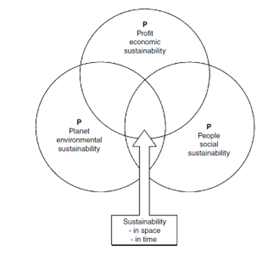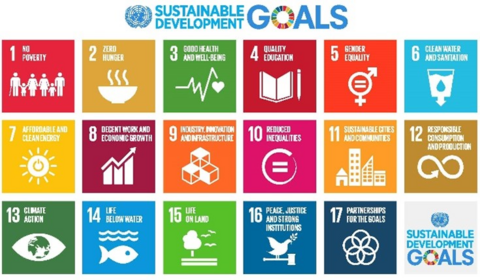Sustainability Issue
Contents |
Abstract
In order to find the solution to a problem, first of all it is needed to accept the problem as true and relevant. Although in previous years the problem of ecological impact was not known, not only the damage to the atmosphere, but also the consequences on society, nowadays, the increase of sustainability in companies’ strategy and goals provide a promising future. In this frame of reference, companies have a key role to play due to their great influence in society thanks to their campaigns based on the idea of satisfying the needs of the customer by means of the product and the whole cluster of things associated with creating, delivering and finally consuming it.
Taking into consideration sustainability requirements, it is needed a change in the field of project management from the perspective of time, budget, and quality to social, environmental, and economic [1]. The change in the paradigm of project management is one of the essentials aspects for which sustainability plays a relevant role. This change is based on moving from predictability and controllability to an environment based on flexibility, opportunity, and complexity. Considering sustainability, it requires a change of mentality from the part of the project manager, for instance, it is not only necessary to provide the expected results but also to assume the responsibility for the long-term growth of organizations and society [2]. In order to find the balance between economic knowledge, social well-being and the rational use of natural resources, sustainable development is necessary and companies are incorporating it into their respective spheres of influence. Sustainability gives to the organization a huge competitive advantage, an improvement in relations with its stakeholders to the organization and contributes to support declining resources.
Sustainability
Concept
Sustainability has developed quickly over the past few years but there is still a problem of how to implement sustainability into practice to get positive results and overcome the barriers that face organisations and project teams [3].
Although sustainability has not sometimes been defined clearly enough among companies, during the recent years many firms have tried to become environmentally friendly. Sustainability has been adopted by many organizations through their mission and their strategy. However, the social and environmental dimensions of sustainability are difficult to incorporate into programs and projects to execute the organization's strategy. Then, it is not enough producing without emitting polluting emissions, it is very necessary that the whole system is reviewed and redesigned to fulfil with the customer requirements and the organization needs in a sustainable manner [6]. In this frame of reference, Elkington developed the concept of Triple Bottom Line which proposed that business goals were inseparable from the societies and environments within which they operate.
This concept englobes the economic, environmental and social goals which are aligned and make an impact on the decision and the actions taken by the organizations. Furthermore, this innovative concept is present in the UN World Business Council for Economic Development (WBSCD) [7]. A group of 150 international companies put into practice the principles of TBL in their business and strategy. Thanks to the application of this concept, they make it possible to address global challenges such as poverty, gender inequality and the depletion of resources. In the WBSCD it is also recommended that, in order to have a greater impact on society, companies become aware of the global challenge that is presented to them and apply the Sustainable Development Goals (SDG), not only to go forward in the sustainable impact, but also in improving their business opportunities.
Sustainable Development Goals (SDG)

The 17 Sustainable Development Goals represent the world community's next step for a paradigm shift in understanding sustainability and fighting inequality and tackling climate change in the next 15 years. In the frame of reference in which we find ourselves, the SDGs ask companies to contribute to solve the challenges of sustainable development within a common framework. It should be noted that each SDG offers an opportunity for companies to increase their impact and strengthen their strategy. The implementation of SDG in a company's strategy leads to the opening not only of new and future business opportunities, but also the ability to stabilize markets and society. In addition, the more organizations that use the tool, the collaboration between them will improve as they will use a common language, they will be able to strengthen their relationships with their stakeholders and they will be able to improve the concept of corporate sustainability. Within these objectives, SDG 5 (Gender equality), SDG 8 (Decent work and Economic growth) and SDG 12 (Responsible Consumption and Production) should be highlighted.
Implementation of Sustainability
The objective of the implementation of sustainability in an organization is to improve the success, the resilience capacity of the company in the long term and to acquire new values. Organizational culture is a result of a complex group learning process and it has been defined as “a pattern of shared basic assumptions that the group learned as it solved its problems of external adaptation and internal integration” [9]. However, the culture can only be applied when communication and interaction between individuals evolve. If it is finally possible to apply this culture, and when it does so robustly, the organization begins to be more effective [9]. It is for this reason that it requires the internal involvement of all individuals to act in accordance with the principles of sustainability. Organizational culture is very important and in fact many studies have shown that failure in change processes can be attributed to the neglect of organizational culture [10].
In order to be successfully implemented, it is necessary that all employees are aware of sustainability values and are prepared to apply them. The best way to successfully achieve this goal lies in the fact that employees must be trained and prepared. Although this transformation is often complicated, it is important to be able to gather knowledge through communication in order to change norms and values related to the environment and socio-economic well-being. Organizations must consider a transformation to chart their path including the inclusive values of sustainability.
Project Management
Project management can be described as the application of a set of processes, knowledge, skills and methods in order to achieve specific objectives for the company that must be accepted within parameters set by the project that is developed in the organization. One of the main characteristics of a Project Management is based on the final delivery, since it is necessary to come to an end. However, if we talk only about management, it should be noted that it is a continuous process where the objectives are regularly changed and improved. Furthermore, it should be mentioned that a project is carried out to achieve defined and planned objectives, which can be quantified in the form of results or benefits for the organization. If the predefined objectives are accomplished, the project is considered a success according to the agreed criteria and within a specific time frame. The basic elements of each project are the following:
•Time : organization and planning of the schedules in which the work will be carried out in order to fulfil the project's objectives.
•Cost : know the necessary economic amount that is requested to execute the project.
•Quality : assess the level of the objectives achieved and the initial purpose for the development of the project.
The objective of Project Management is to obtain a final product or service that brings a benefit to the organization and that meets the requirements initially marked when the project was defined [11].. When it comes to getting the final result, you need to take into account the control and planning of the tasks necessary to carry it out. Those companies that decide to perform their work with project management lead to guarantee an efficient use of resources, satisfy the needs of the project's stakeholders and enable the desired result of the project to be more successfully achieved.
Overview
Stakeholder analysis
Project Manager
Methodology
Limitations
References
- ↑ BANADUC, G., MIREA, N. y DRAGHICI, A., 2022. Points of intersection between sustainability and project management. MATEC Web of Conferences, vol. 373, pp. 78-. ISSN 2261-236X. DOI 10.1051/matecconf/202237300078
- ↑ UKAGA, O., 2014. Gilbert Silvius, Ron Schipper, Julia Planko, Jasper van den Brink and Adri Kohler: Sustainability in project management: Grower Publishing Limited, Surrey, England, 2012, ISBN 978-1-4094-3169-5. 2014. Dordrecht: Springer Netherlands.
- ↑ Talbot, J., & Venkataraman, R. (2011). Integration Of Sustainability Principles Into Project Baselines Using A Comprehensive Indicator Set. The international Business & Economics Research Journal , 10 (9), 29.
- ↑ Lecture 1: 42402 – Sustainable Operations and Supply Chain Management. Sustainability and the role of Operations and Supply Chain Management
- ↑ Brundtland, G.B. (1987): Our common future: World Commission on Environment and Development, Oxford University press; p.54.
- ↑ ANALIA SANCHEZ, M., 2015. Integrating sustainability issues into project management. Journal of cleaner production, vol. 96, pp. 319-330. ISSN 0959-6526. DOI 10.1016/j.jclepro.2013.12.087
- ↑ https://www.wbcsd.org/
- ↑ https://b1g1.com/sustainable-development goals
- ↑ 9.0 9.1 Schein, E. H. (2006). Organizational Culture and Leadership. John Wiley & Sons.
- ↑ Cameron, K. S., & Quinn, R. E. (2011). Diagnosing and changing organizational culture: Based on the competing values framework. John Wiley & Sons..
- ↑ Lecture 1: 42433: Advanced Project, Program and Portfolio Management.